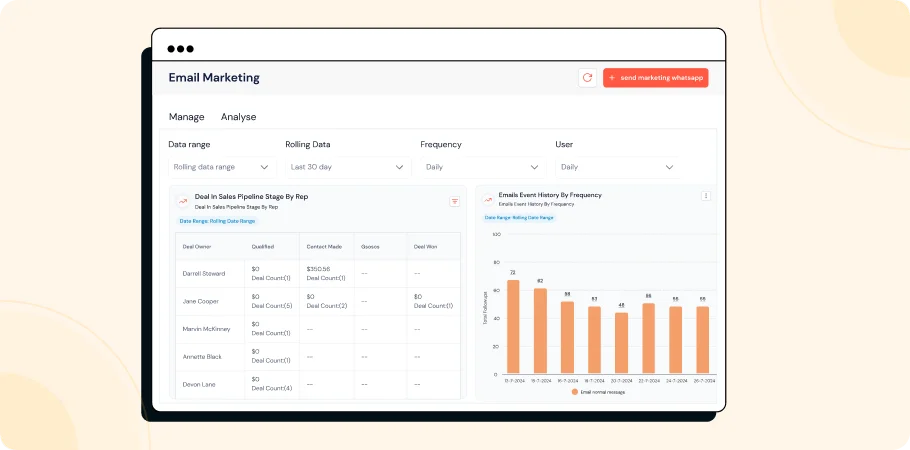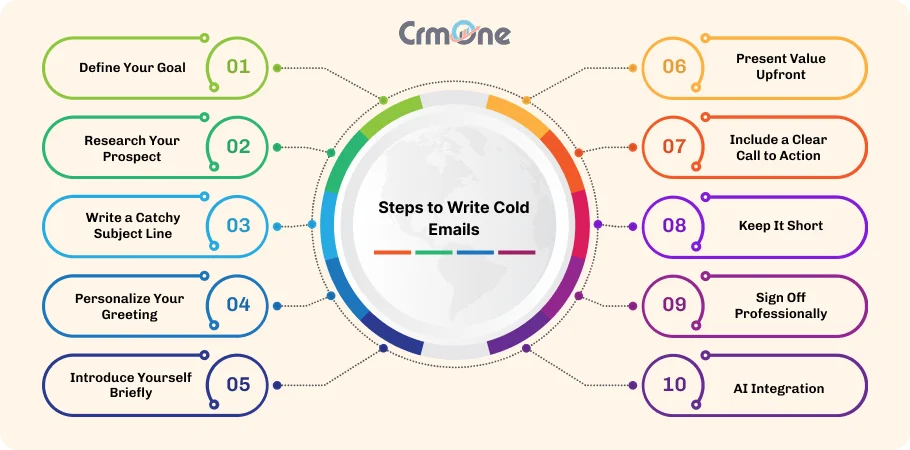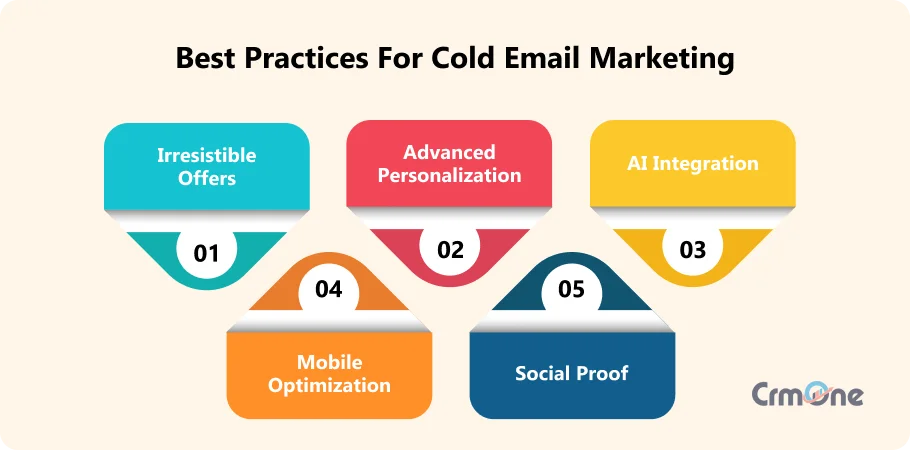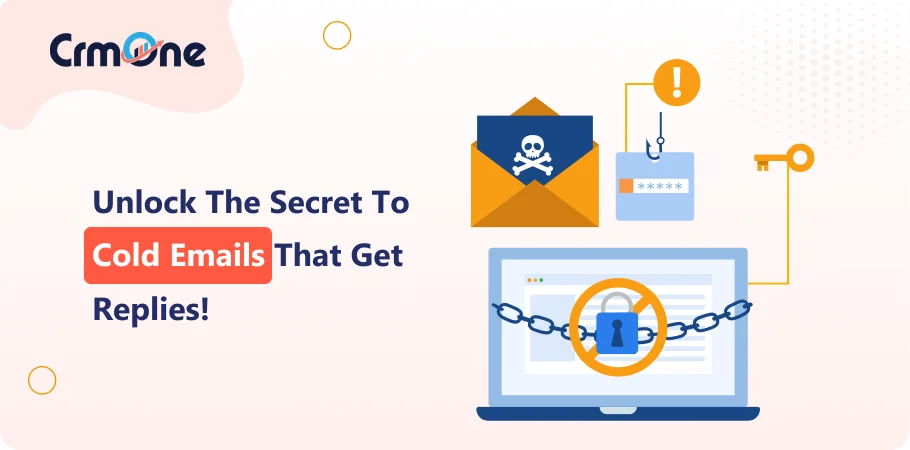Don’t be generic! That’s the first thing I recommend while doing cold email marketing. If you don’t know who your customers are, then research about them using AI in cold email software and marketing.
Instead of rushing in the inbox, plan the strategy, because that would yield positive results. Rather than your email just sitting idly, it would become a source of revenue generation.
Personalized email content increases average cold email response rates by 32.7%. There are several indicators and steps to follow that we will discuss today, including how to write cold emails effectively. Let us understand how it works.
What is Cold Email Marketing?

Basically, it’s an unsolicited message sent to a recipient without any prior contact. You are starting a conversation with a potential client, customers or new business owners.
Cold emails are used in campaigns to introduce a product or service, make requests, or build connections.
Cold emails are different from spam. While spam is sent to anyone, cold emails are often personalized and aimed at specific people.
Cold email marketing is most effective when it’s personalized, targeted, and sends a strong message. An email automation tools can help with this.
Successful cold emails can spark important business talks and connections. This can lead to sales opportunities. The average response rate for cold emails is about 8.5%. However, a well-written email can boost engagement and conversion rates a lot.
How to Write Cold Emails in 9 Easy Steps?

Okay, let’s start!
So you don’t have to put all at once. Don’t overwhelm them, don’t confuse them, most importantly don’t sell them at the starting.
Use AI in email marketing; understand your customer first, then start preparing the email campaigns.
1. What do you want to achieve?
Be sure about why you are sending the emails. Don’t send a generic one.
The purpose is important! Are you looking to schedule a meeting to introduce your Product or gather feedback?
A clear goal will help shape your message. Knowing how to write cold emails effectively ensures good engagement.
Example: If your goal is to set up a meeting, state that upfront in the email.
2. I should definitely know my customer
So, what if it’s the first email from your brand/company to the customer. Do not send it without doing proper research about them.
Getting to know them will set your ideologies align with them. Use CRM tools for email marketing to scan their social media profiles, what they searched online recently, or what are the issues they have been facing.
Then, plan how your products can resolve those issues.
Take time to learn about the right person or company you are contacting. Understanding their needs and interests allows you to tailor your message effectively.
If reaching out to a marketing manager, mention a recent campaign they ran and express genuine interest in their work.
3. Craft a Compelling Subject Line
I personally open emails with catchy subject lines. They create a good impression.
Make sure that the subject line is engaging and relevant to the user’s needs. This will intrigue them to open your email. Knowing how to write cold emails with good subject lines improves open rates.
Wrong Subject Line:
“Buy Our Product Now!”
This subject line is overly aggressive and sales-focused, which can turn off potential recipients immediately.
Correct Subject Line:
“How [Recipient’s Company] Can Benefit from Our Solution”
This subject line is more inviting and tailored, suggesting a mutual benefit and prompting the recipient to open the email to learn more.
There are so many emails in the inboxes these days. The only way to stand out is to be creative and still relatable with your brand tone.
Note: Personalized subject lines increase average cold email open rates by 50%
4. Personalize Your Greeting
The difference between your social media, blog post, and email is ‘personalization.’ You are having going to have one on one conversation with the prospect.
Address the recipient by Name and include a personal touch that shows you have done your homework.
Example: “Hi Sarah, I loved your recent article on digital marketing trends.”
You convert prospects to potential customers by showing your interest in them, not by just marketing your company website and products.
Tips:
- Use Recipient’s Name
- Mention Recent Achievements
- Reference Shared Connections
- Highlight Relevant Interests
- Include Specific Details
5. Introduce Yourself Briefly
Now, let’s go to the body part of the email. Your email’s introduction part should not be boring. That’s how you write cold emails now.
It should be concise that explains who you are and why are you reaching out. The relevant interest should be mentioned in it.
Keep your introduction short and to the point. Write only one or two sentences that clearly explain the important things.
Mention something specific that relates to the recipient’s work or recent achievements to show you’ve come prepared.
Example of a Good Introduction:
Hi Sarah,
I’m Alex Johnson, the new marketing manager at XYZ Company. I noticed your recent campaign on social media, and I’m impressed by how you engaged your target audience. I’m reaching out because I think our new analytics tool can improve your campaign tracking.
Example of a Poor Introduction:
Hello,
I’m writing to introduce myself. My Name is Alex Johnson, and I work at XYZ Company. We sell various marketing tools, and I thought you might be interested in hearing about them.
Why the Good Example Works:
- It is brief and to the point.
- It relates directly to the recipient’s tasks.
- It provides a clear purpose for the email.
Why the Poor Example Fails:
- It lacks engagement and personalization.
- It does not relate to the recipient’s interests or needs.
- It feels generic and impersonal, which can lead to disinterest.
6. Present Value Upfront
You have set the stage right. The prospect knows about you. They understand that you are not just any other brand offering generic products; instead, you are capable of solving their problems.
‘Hit the Hammer at the Spot’
Articulate what value you offer after the introduction part. Highlight how your proposal/product can benefit them and make their life easier.
This will be a direct connection between your brand and the next prospect’s attention. So, they will feel valued and this increases the chance of response.
Example: I believe our analytics tool can help track your campaign and improve ROI.
Here you can attach a proof of your past achievements with other clients. Show them how you were able to increase sales. This will build trust among them and they are more likely to purchase your services.
7. Include a Call to Action
Everything was going well till the end but this line, ‘Buy our services now’. It scared the prospect. Even though he was genuinely interested in what you were offering, there are high chances that such Call to Action lines will drive all your efforts in vain.
Do not stress them out; they will never return or open your email again.
Call to Action should be easily achievable. Here, you have to do indirect sales rather than direct.
Guide them on what to do next. This would encourage them to respond or take the desired step.
Example: “Would you be open to a quick call this week to discuss how we can work together?”
This will lead them to take the next step easily, and then you can plan the ‘sales strategy.’
Boost Your Business
Performance with CrmOne
Our experts will guide you through the most effective
ways to use CrmOne,
ensuring you fully leverage its
features for maximum impact on your business.
8. Keep the Email Short and to the point
Value the time of your recipients. Keep your email in brief. Go for clarity and avoid adding un-necessary elements or lengthy explanations.
Focus on delivering your message without unnecessary fluff. Aim for clarity in your writing to ensure your main points stand out.
Try to restrict your email to three short paragraphs. Each paragraph should serve a specific purpose: introduce yourself, present your value proposition, and include a clear call to ActionActionAction.
Wrong Way
I wanted to reach out because I think your social media campaigns could use some improvement. Many companies struggle with engagement, and I believe our software can help.
We have various features that might interest you, and our pricing is competitive. Let me know if you want to discuss this further.
Correct Way
I noticed that your recent social media campaign faced challenges with audience engagement and reach.
Many brands experience similar issues when trying to connect with their target demographic.
At [Your Company], we specialize in data-driven strategies that refine targeting and enhance content effectiveness. I’d love to share insights on how our analytics tool can help your brand increase engagement and achieve high ROI.
9. Sign Off Professionally
End your professional email signature with a polite closing statement and include your contact information for easy follow-up.
Example:
Looking forward to hearing from you!
Best regards, Alex Smith, [Your Position], XYZ Company, [Your Phone Number].’
By following these nine easy steps, you can create cold emails that stand out in crowded inboxes and foster meaningful connections in prospects inboxes. Happy emailing!
How to Ace the Cold Email Marketing Game? – Best Practices

Make me an offer; I can’t refuse!
You want customers to shop from you, create offers that are worth responding to by highlighting your product/service’s USP. Make them understand that this is the best offer they will get. It’s too much competition, giving offers will reduce the traffic.
Personalize everything:
Use enriched prospect data to create personalized email copies. If you think just using the names is personalization then you are WRONG. Go beyond it and be specific in addressing to their specific needs and interests.
Use AI in email marketing:
Let’s say a customer saw your email at 1 am in the morning and you are not in the office. What now? They want instant reply, someone who can have a conversation with them about the products and solve their queries.
Hence, using AI has become very prominent. Such as CrmOne’s Aeri can give replies acting as a human by framing the message according to the data of customers.
Read more: Bulk Email Software & Advantages of Email Marketing
Mobile-Friendly Subject Lines:
Keep subject lines short (30-50 characters) to ensure full visibility on mobile devices. This is one of the common issues with brands. You have to get this: ‘Majority of your customers are on smartphones checking their emails.’
The email should be compatible with the mobile screen. Else, within seconds they will back out from the message.
Give them Social proof:
As discussed above, support your claims with testimonials, statistics, and case studies to highlight specific things. This will form a trust among them.
Cold Email Marketing Examples:
1. Getting the interview
Applying for a Job
Subject: Passionate [Your Field] Professional Seeking Opportunities at [Company Name]
Dear [Hiring Manager Name],
I’m a [Your Field] expert with [Number] years of experience. I have a strong passion for [Specific Area of Interest within the Field]. I’ve been consistently impressed by [Company Name] ‘s work in [Specific Project/Achievement].
I’m keen to explore ways I can use my skills to help your sales team. I’ve attached my resume for you to look at. I’m happy to chat whenever it works for you.
Thank you for your time and consideration.
Sincerely,
[Your Name]
[Your LinkedIn Profile URL (Optional)]
2. Making a Business Deal
Asking for Business Collaboration
Subject: Collaboration Idea: [Your Company] + [Their Company] – [Specific Benefit]
Dear [Name],
I’m [Your Name] from [Your Company]. We [briefly describe your company in one sentence].
I’m reaching out with a collaboration idea: [Clearly and concisely state the potential partnership and its primary benefit for them]. We believe this partnership would [briefly outline the mutual advantages, focusing on what’s in it for them].
[Your Company] can offer [Your key contribution]. Would you be open to a quick chat next week to explore this further?
Thanks,
[Your Name]
3. Impact on Customers
Sending personalized offers
Subject: Have you tried our new [Product] yet?
Hi [First Name],
[Your Name] from [Your Company] here. We recently launched an insightful B2B sales podcast called Revenue Champions, which I thought you might find interesting.
Our newest [Product] is finally here and is becoming quite the rage! We’ve helped companies like [Name of 2-3 relevant past customers] achieve [specific results, figures, etc] and I noticed [something related to your offering, ex: “that your team publishes a lot of content.” — if you sell a marketing tool and the prospect’s company publishes a lot of blog content].
Do you have a process for [solution you offer]? If not, I’d love to send over a quick, no-strings-attached video with two simple ways you can [prospect’s pain point you solve].
Best,
[Your Name]
4. How to get Response
Following up after not getting replies
Subject: Following Up: [Original Subject Line or a Variation]
Hi [First Name],
I hope this finds you well.
I know you’re busy, and my last email may have been overlooked. I’m following up about \[briefly reiterate the original offer or value proposition\].
We’ve just [share a new development, success story, or added benefit related to your offer]. I thought this might be relevant to [their company/industry].
Are you interested in exploring this further? If not, that’s fine—just let me know, and I’ll step back.
Thanks for your time,
[Your Name]
FAQ’s:
1. How many emails do I need to send to get a sale?
It can vary. If you convert 25% of your opportunities and require 50 emails for a reply, you should plan to send around 200 emails for every sale.
2. What should I include in the email body part of my cold email?
- Start with a friendly greeting.
- Explain why you’re getting in touch.
- Highlight the benefits for the recipient.
- Include social proof to build trust.
- End with a clear call to ActionActionAction.
3. What should I avoid saying in a cold email?
Avoid spammy words, false promises, overly formal language, and robotic tones.
4. How can cold emailing help my business?
Connect with new customers. and social media links Reach out to influencers. Build links to improve search rankings. Also, look for collaboration opportunities.
5. How effective is cold email marketing?
Open rates can be around 24%, but vary greatly depending on your targeting and messaging. Track your email performance. Make changes if necessary.
6: Okay, so I sent an email. How long do I wait before bugging them again?
Wait 2-3 DAYS for the first follow-up. Then, space them out a little longer – maybe a week apart after that. Don’t be a pest!
7: How many follow-up emails should I send? I don’t want to be annoying!
Send about 4 to 9 follow-ups TOTAL. If they still don’t answer after a few tries, give up.
8: How long should these automated follow ups back-up emails be? I’m not writing a novel!
Keep it SHORT! Around 120 words, maybe 15-20 lines. Short paragraphs and bullet points make it EASY to read.
Get started for Free
Start for free today. Boost your sales by clicking the Get Started button. With CRMOne, you can manage leads, sales, and customer service all in one place.

